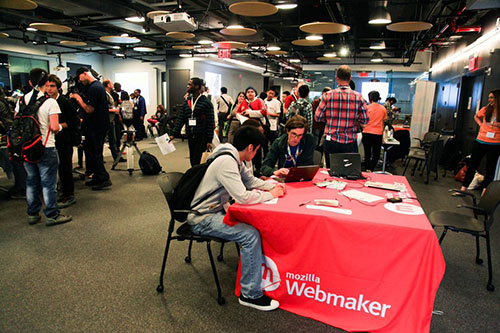
“No matter the platform, people will always need to know how to understand, analyze and reflect upon larger contexts and systems. That pro-active creation and larger understanding are the ways to reach the end goals of digital and web literacy.” – Leah Gilliam
The goal is to create meaningful and relevant learning experiences outside of the classroom where youth can learn by action. Mozilla Hive NYC Learning Network was launched in 2007 and has since spread globally to reach millions of learners around the world. Hives are comprised of organizations such as libraries, museums, after school programs, code clubs and non-profit start-ups. Together, they engage and enable young people to explore their passions, and to develop and diversify their key 21st century skills.
In a technology driven world, what should the goals be when you set out to teach for the new media? What are the challenges and what are some of the strategies that have proved successful? I invited Leah Gilliam, the Director of Mozilla’s Hive NYC Learning Network, to share her perspectives.
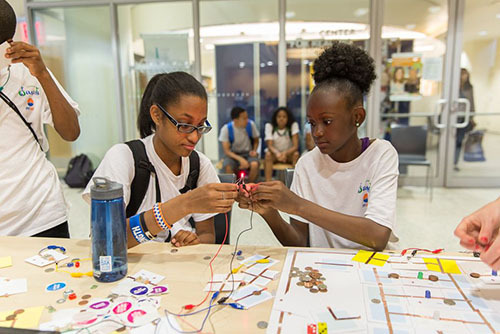
“Our work is driven by the research and design principles of connected learning and a specific desire to make how and what people learn relevant.” – Leah Gilliam
Leah, what do you believe is the biggest impact that technology has had on education in the last decade?
The advent of mobile and social networks has had a groundbreaking impact on how we teach, interact and learn with technology. I love that people are carrying powerful computers in their pockets and are able to explore, share and connect–on their own time at their own pace. My real concern is that mobile technology should also be a tool for people to create and construct meaningful content as well–that’s a harder proposition but one we’re working on with Mozilla’s Webmaker platform and tools like AppMaker, a free way to build personal mobile apps.
What are your goals when you set out to teach for the new media?
My goal is always to have people think critically and respond creatively to the world and the conditions around them. No matter the platform, people will always need to know how to understand, analyze and reflect upon larger contexts and systems. That pro-active creation and larger understanding are the ways to reach the end goals of digital and web literacy. Empowering others to create and control their digital lives through and with a technology’s building blocks is of utmost importance. It’s also crucial in our work with youth and educators to empower others to share what they know and teach it to others.

“One of the big challenges we face is helping people build their ideas and learn new things in a networked way.” – Leah Gilliam
What do you believe are the important building blocks for teaching youth how to use media in both a creative and a meaningful way?
Every user should know how to read and write with the technology around them. Not just how to use it or play it but also how to change it and make it work on a user’s own terms. At Mozilla and through Hive Learning Networks, we believe strongly that making can fuel learning. Our goal is to seed the conditions that foster the transformative moments of awareness that breed those larger “hacker” and web literacies. Our work is driven by the research and design principles of connected learning and a specific desire to make how and what people learn relevant. To that end, we design and support social, participatory and interest-driven opportunities that really stick with learners.
Mozilla’s Maker Party initiative is a great example. It is a global effort (happening right now) that brings people together to make, learn and explore in a social atmosphere. It has a specific focus on using digital media and the web as platforms for creativity. This summer alone, we’ve seen more than 455 people step up to help Mozilla teach the web by throwing more than 1220 events in over 260 cities around the world from July to September.
What are the challenges you face in training today’s educators? Are these challenges different from preparing today’s youth? Can you share one or two of the best strategies you have used to overcome the key issues?
Hive creates opportunities that enable learning through hands-on making and exploration with peers and mentors. One of the big challenges we face is helping people build their ideas and learn new things in a networked way. Computer and neural networks are often streamlined and highly efficient. In contrast, learning networks are made up of people sharing information and knowledge and then building upon what they’ve exchanged–they work very differently. Another challenge in this work is creating the opportunities for busy people to develop the ties and broker the relationships that support the exploration, problem identification and discovery that fuel invention. It takes time, space and reflection to engage in the cross-organizational and interdisciplinary partnerships that Hive Learning Networks foster. Although our work with youth takes different forms, the core principles and practices are the same: we strive for interactions that are creative, collaborative, participatory, relevant and openly networked.
We describe Hive NYC as a learning laboratory because of the work we do to create a space for people to explore, create and share together in new ways. One successful strategy we use in this laboratory approach is planning and play-testing new tools and practices that help community members sharpen their ability to identify problems and challenges.
How we work and learn as a team is inspired by open-source technology. It’s predicated on the idea that creating solutions that are interoperable and accessible to others makes them stronger and more robust. Across Mozilla/Hive, we use open collaborative documents and try to formulate questions and prompts that get people working and thinking together in a deeper way.
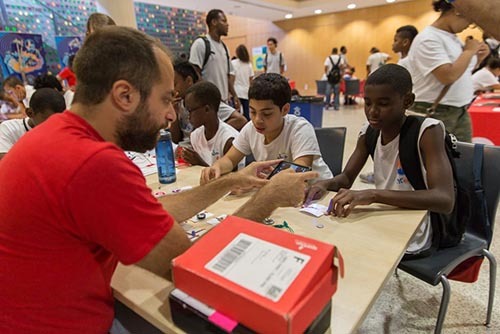
“Another challenge in this work is creating the opportunities for busy people to develop the ties and broker the relationships that support the exploration, problem identification and discovery that fuel invention.” – Leah Gilliam
Can you share some examples of great ideas that have come out of connecting educators and innovators in the learning space? Have you been able to get widespread distribution for any of these ideas? If yes, please explain.
Hive Pop-Ups – creating a fun, party-like atmosphere for learning and sharing digital and analog skills — was a local innovation and the original idea that seeded the Maker Party campaign. It is a practice that has been adopted by larger audiences as a way to successfully expose others to a make-to-learn approach.
The million dollar (rhetorical) question is how do you create engaging, meaningful and relevant learning experiences with quality, fidelity and scale. It’s the focus of Hive NYC’s work going forward–taking the practices and ideas we’ve helped to pilot successfully in a few environments and expanding their dissemination and reach.
For other articles on online learning: Online Learning
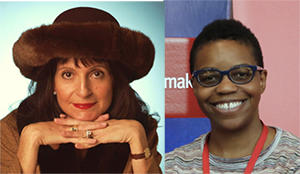
C.M. Rubin and Leah Gilliam
Photos are courtesy of Mozilla Hive NYC Learning Network
For more information visit http://hivenyc.org.
Join me and globally renowned thought leaders including Sir Michael Barber (UK), Dr. Michael Block (U.S.), Dr. Leon Botstein (U.S.), Professor Clay Christensen (U.S.), Dr. Linda Darling-Hammond (U.S.), Dr. MadhavChavan (India), Professor Michael Fullan (Canada), Professor Howard Gardner (U.S.), Professor Andy Hargreaves (U.S.), Professor Yvonne Hellman (The Netherlands), Professor Kristin Helstad (Norway), Jean Hendrickson (U.S.), Professor Rose Hipkins (New Zealand), Professor Cornelia Hoogland (Canada), Honourable Jeff Johnson (Canada), Mme. Chantal Kaufmann (Belgium), Dr. EijaKauppinen (Finland), State Secretary TapioKosunen (Finland), Professor Dominique Lafontaine (Belgium), Professor Hugh Lauder (UK), Professor Ben Levin (Canada), Lord Ken Macdonald (UK), Professor Barry McGaw (Australia), Shiv Nadar (India), Professor R. Natarajan (India), Dr. Pak Tee Ng (Singapore), Dr. Denise Pope (US), Sridhar Rajagopalan (India), Dr. Diane Ravitch (U.S.), Richard Wilson Riley (U.S.), Sir Ken Robinson (UK), Professor PasiSahlberg (Finland), Professor Manabu Sato (Japan), Andreas Schleicher (PISA, OECD), Dr. Anthony Seldon (UK), Dr. David Shaffer (U.S.), Dr. Kirsten Sivesind (Norway), Chancellor Stephen Spahn (U.S.), Yves Theze (LyceeFrancais U.S.), Professor Charles Ungerleider (Canada), Professor Tony Wagner (U.S.), Sir David Watson (UK), Professor Dylan Wiliam (UK), Dr. Mark Wormald (UK), Professor Theo Wubbels (The Netherlands), Professor Michael Young (UK), and Professor Minxuan Zhang (China) as they explore the big picture education questions that all nations face today.
The Global Search for Education Community Page
C. M. Rubin is the author of two widely read online series for which she received a 2011 Upton Sinclair award, “The Global Search for Education” and “How Will We Read?” She is also the author of three bestselling books, including The Real Alice in Wonderland, is the publisher of CMRubinWorld, and is a Disruptor Foundation Fellow.
Follow C. M. Rubin on Twitter: www.twitter.com/@cmrubinworld


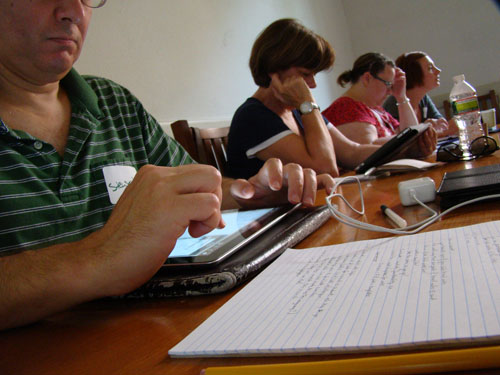
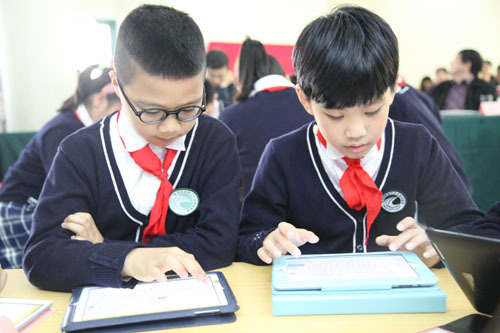
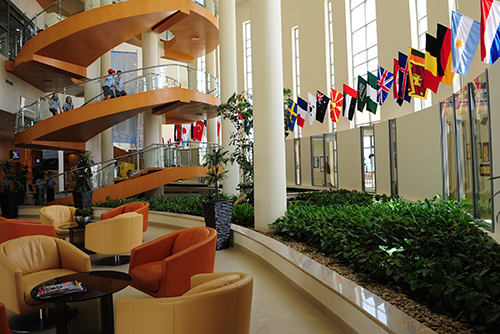
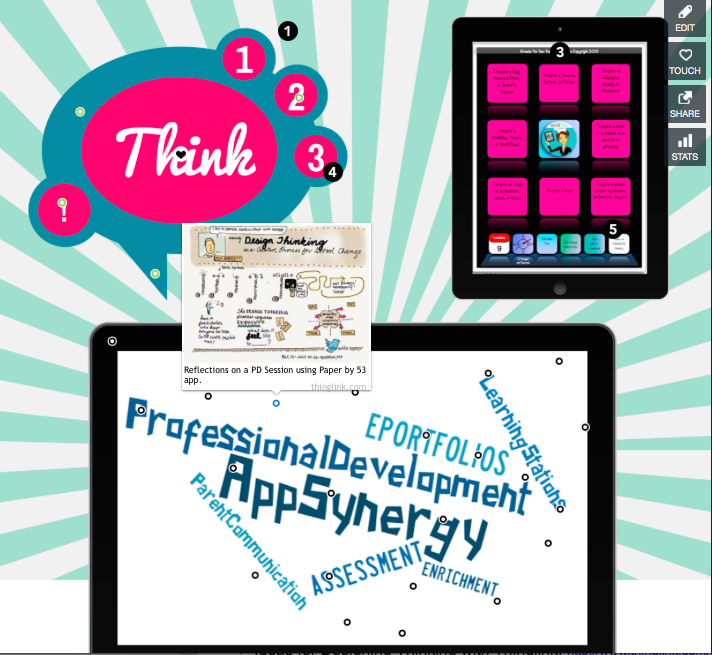
Recent Comments